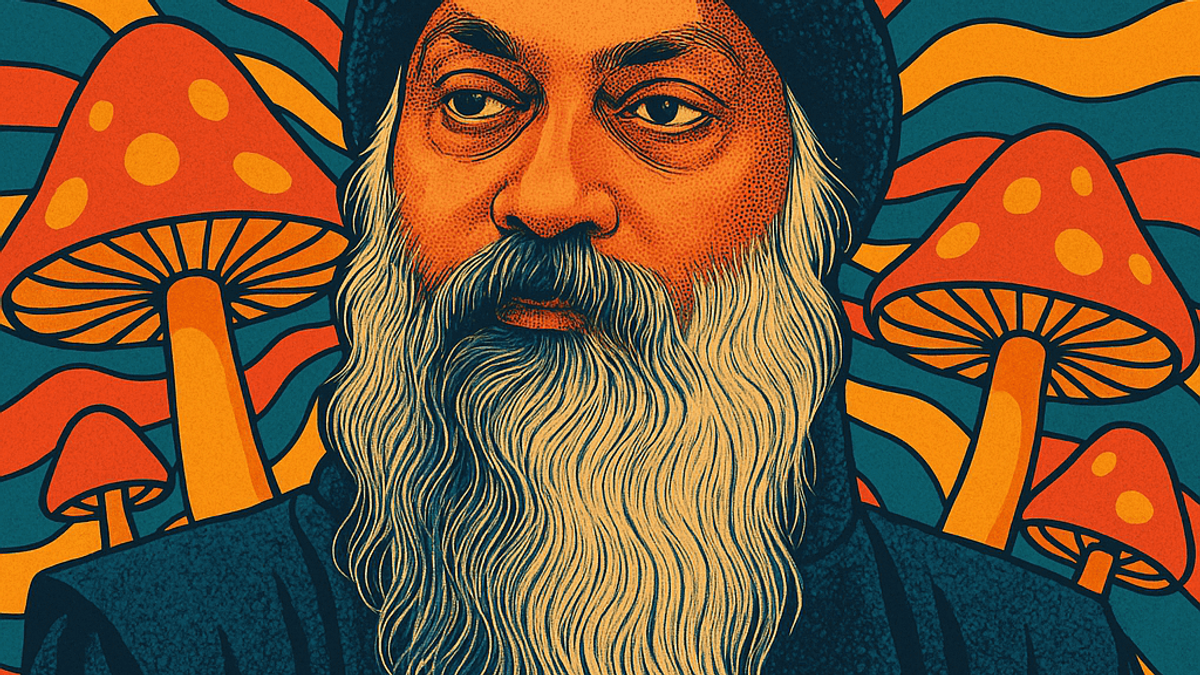
Osho and the War on Consciousness: The Psychedelic Path Without the Substance
In the hidden architecture of power, where governments not only police behavior but the very states of mind their citizens may access, one figure looms large: Bhagwan Shree Rajneesh, known as Osho. Unlike Timothy Leary or the psychedelic pioneers of the 1960s, Osho did not rely on substances to shatter illusions. Instead, he taught living methods — breath, movement, catharsis, meditation — that could dissolve the ego and reveal the true self.
“If you can be silent, meditative,” Osho once said, “then whatsoever psychedelics can give you, you can have — and more, and without destroying your system.”
(The Book of Secrets)
Where mushrooms or LSD could fling open the window for a few hours, Osho built staircases to the same view.
Psychedelics: Shortcuts That Shook Authority
The 1960s showed what happens when millions glimpse life beyond the monkey mind. Psychedelics sparked awakenings that fueled rebellion: antiwar protests, communal living, and experiments in love and spirituality. But as Nixon aide John Ehrlichman later admitted, the “war on drugs” was never just about public health — it was a strategic tool to suppress counterculture and communities of color.
From the state’s view, psychedelics weren’t recreational drugs; they were ideological explosives. They dismantled the ego structures that made obedience possible.

Osho: A Staircase to the Same Summit
Osho saw what psychedelics revealed — the sudden disintegration of ego and the encounter with the true self. But he also saw their limits.
“Drugs can open a door,” he said, “but you will be thrown out of it again. Meditation is the key that opens the door forever.”
(From Darkness to Light)
His methods were engineered to create those breakthroughs without chemicals:
- Dynamic Meditation: rapid breathing, catharsis, silence.
- Dance and music: surrendering until only awareness remained.
- Everyday mindfulness: making the present moment a continuous practice.
- Radical acceptance of desire: using life energy, not suppressing it, to reach higher states.
As Thirdi’s essays on the true self describe, enlightenment isn’t about becoming something new but peeling away what you are not. Osho’s work paralleled this exactly: stripping away conditioning until only presence remained.
Why the State Saw a Threat
From the perspective of intelligence agencies and law-and-order politics, Osho’s methods were even more dangerous than LSD. You can ban a mushroom; you can’t ban breathing. His commune in Oregon, Rajneeshpuram, embodied these teachings — communal life, sexual liberation, disdain for organized religion and capitalism. For the guardians of order, it was a red flag.
The 1984 salmonella attack by his secretary, Ma Anand Sheela, gave authorities all the pretext they needed. Soon after, Osho was arrested, shuffled through U.S. detention centers, and later alleged he was poisoned with thallium during custody. “They have poisoned me in America,” he told followers in 1987, pointing to nerve damage and pain. Official records list heart failure as his cause of death in 1990, but no autopsy was ever performed.
Whether poisoned or undone by stress, his health collapsed after state intervention. Like psychedelics, his staircase to freedom was effectively suppressed.
Mushrooms and Osho: Two Routes, One Repression
Seen together, the symmetry is striking:
- Mushrooms: shortcuts — glimpses of true self and interconnectedness, criminalized in the 1970s.
- Osho’s path: staircases — daily practices for ego dissolution and presence, crushed under legal and political pressure in the 1980s.
Both challenged obedience. Both opened a way to live outside the fear-and-consume cycle. Both provoked the same reflex from those in power: suppression.
Legacy: The Whisper of Freedom
Osho’s message remains aligned with what psychedelics reveal: the true self is always there, beneath the noise of the monkey mind.
“Your real being is hidden behind the mind,” he taught. “Once you are beyond the mind, you are beyond all boundaries.”
(The Book of Secrets)
That is why both paths — mushroom shortcuts and Osho’s staircases — remain controversial. They dissolve the boundaries that systems of power depend on. His story is a reminder: the war on consciousness is not just about drugs or gurus. It is about the fear of awakening itself.